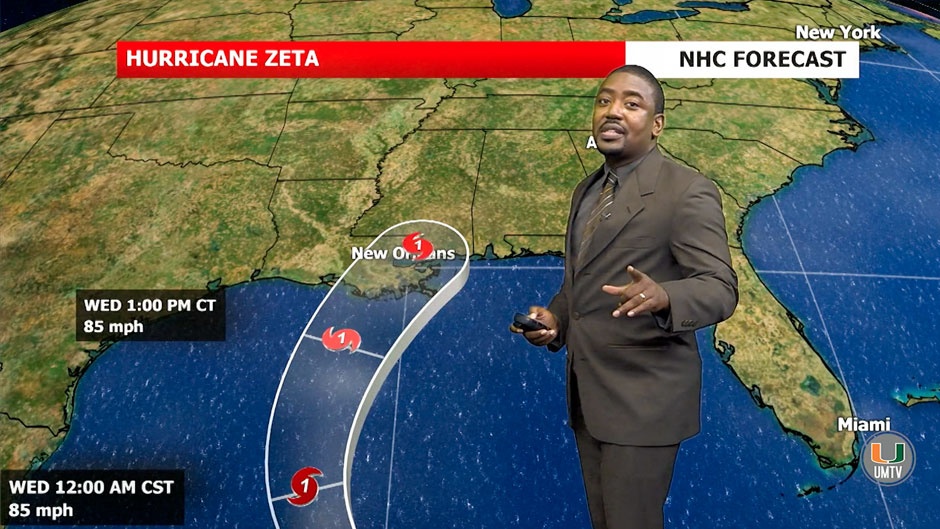Standing in front of a blank green screen that appeared as a moving weather map to television viewers, Touri White delivered his Oct. 27 UMTV CanesCast with ease, mixing in a little bad news with the good: Hurricane Zeta had just hit the Yucatan Peninsula and was now barreling toward Louisiana. But in South Florida, the weather was balmy with nighttime temperatures in the mid-70s and little to no chance of rain.
White’s forecast ended with a seven-day weather outlook, but the University of Miami graduate student had one more vital piece of information to share with viewers—a lesson on climate change to augment his forecast. Warming ocean temperatures are fueling more intense Atlantic hurricanes, and melting glaciers are contributing to sea level rise, both of which couldn’t be more relevant for South Florida, he explained.
“This is a rarity in the industry,” said White, who is earning his master’s degree in coastal zone management with an emphasis on broadcast meteorology, a dual track with courses offered in the School of Communication and Rosenstiel School of Marine and Atmospheric Science.
“A few on-air meteorologists are now beginning to incorporate climate-related reports into their forecasts, but it’s not as prevalent as it should be,” he said. “Weather, like anything else in news, is about storytelling. And there are some very compelling and fascinating aspects of climate that make for excellent stories and can be easily rolled into a local weather forecast.”
White’s combination weather-climate report was a first for UMTV’s CanesCast.
A course on climate change taught by Rosenstiel School climatologist Amy Clement inspired White to come up with the idea for the special report. “I worked with Dr. Clement and some of my classmates to produce a package with scripts and storyboards,” White said.
Clement even appeared in the inaugural segment, explaining in her portion of the report that the increases in greenhouse gas emissions we have observed in Earth’s atmosphere are human induced, and that South Florida, in particular, faces the daunting challenge of being vulnerable to sea level rise and tropical storms.
“In the real world, it is fairly unusual to have a climate segment at the end of a weather report in a newscast. It’s not typically practical, and most producers and news directors have a strict regimen setup of what their show will look like, particularly a weather hit, on a day-to-day basis,” said Dave Downey, a senior studying meteorology and broadcast journalism, who is the co-founder and executive producer of CanesCast. “Most viewers thought it was interesting to have a climate special and found it an important issue, especially considering it aired the week before the election.”
White hopes to play a major role in creating future climate reports and agrees with CanesCast producers that the segments are beneficial for viewers.
“Considering how active last year’s hurricane season was, many of our viewers thought it was refreshing to see climate change addressed in our local weather coverage because of its importance and its impact on storms,” said Jackson Dill, assistant station manager at UMTV and executive producer of CanesCast, who pulled together video footage and graphics for the report.
For his part, White is intent on a career in broadcast meteorology. A former teacher in the Miami-Dade school system who also mentored youth as the director of the Frost Science Museum’s Upward Bound Math and Science program, White would like to see more female and male students of color in the meteorology field.
“We have to reach kids when they are young and focus on initiatives that spur their interest in STEM,” he said.
Positive role models are also important, he said, noting WPLG Local 10’s chief meteorologist Betty Davis and NBC 6’s Ryan Phillips.
White’s interest in all things weather developed at an early age. In the early 1980s as an anxious 6-year-old, White would often find safety and a sense of security in his grandmother’s arms whenever a violent South Florida thunderstorm struck, frightening him with its streaks of lightning and thick blankets of rain.
“I was frightened but inquisitive,” White recalled. “I wanted to know everything about weather.”
Why does it rain? What causes thunder and lightning? Why do tropical cyclones form? White had an endless barrage of questions, and his grandmother encouraged him to follow his two passions—astronomy and meteorology.
He eventually gravitated toward the latter. “But I’m still in love with astronomy,” he said, “as the two fields actually are related in many aspects.” The moon, he pointed out, can affect atmospheric pressure in much the same way it affects tides. Likewise, sunspot activity has an impact on Earth’s climate and weather.
White says weather forecasts are arguably the most important part of any newscast. “We’re above sports, right after the meat and potatoes of the news,” he explained. “But it stands out because we’re all impacted by the weather, no matter where we are.”

